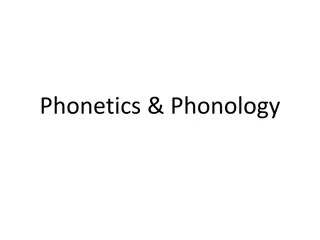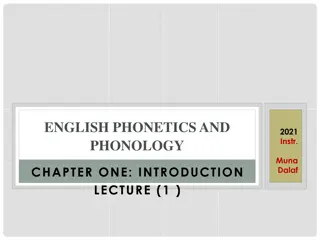Understanding the Basics of Phonetics and Linguistics
Explore the fundamentals of phonetics and linguistics, covering the components of language, the speech mechanism, respiratory system, articulatory system, phonatory system, voiceless and voiced sounds, and more. Dive into Dr. Somali Saha's "An Introduction to Phonetics" to grasp how sounds are articulated, transmitted, and received in speech.
Download Presentation

Please find below an Image/Link to download the presentation.
The content on the website is provided AS IS for your information and personal use only. It may not be sold, licensed, or shared on other websites without obtaining consent from the author. Download presentation by click this link. If you encounter any issues during the download, it is possible that the publisher has removed the file from their server.
E N D
Presentation Transcript
An Introduction to Phonetics Dr. Somali Saha
Components of Linguistics Phonetics: Articulation, transmission and reception of speech Phonology: How sounds function in a language. Morphology: Word-systems-words and their structure. Syntax: Sentence-structure of languages. Semantics: Meaning
Phonetics: The Articulation of Speech Sounds The Speech Mechanism The Respiratory System The Articulatory System The Phonatory System
The Speech Mechanism The Respiratory System The Articulatory System The Phonatory System <The Respiratory system lies in the trunk of our body. The Articulatory system lies in the Head and the Phonatory system lies in the throat.
The Respiratory System The Respiratory System consists of : i) the Lungs ii) The muscles of the Chest iii) The windpipe iv)The two tubes which enter the lungs i.e bronchi
The Articulatory System The Articulatory System consists of a few organs in our head and neck. These are called the organs of speech. These organs include the lips, the teeth, the tongue and the palate
The Phonatory System The Phonatory System consists of the larynx and the vocal cords. The larynx is situated in the upper part of the trachea. Inside the larynx are two small structures which look like lips. These are called vocal cords. The space between the two vocal cords are called glottis.
Voiceless Sounds Voiceless Sounds: During normal breathing, the vocal cords move far away from each other and therefore the glottis is wide open. Sounds produced with the wide open glottis are called voiceless sounds.
Voiced Sounds Voiced Sounds: When we articulate certain speech sounds, the vocal cords are drawn close to each other. When the air from the lungs passes through them. The air makes them vibrate. Speech sounds during the articulation of which the vocal cords vibrate are called voiced sounds.
Few Things to Remember All the vowels of English are voiced. Nine out of the twenty four consonants of English are voiced. The vocal cords perform yet another very important function in speech. The rate at which they vibrate determines the PITCH of our voice. When the vocal cords vibrate slowly, our pitch is low and when they vibrate rapidly, our pitch is high.


























